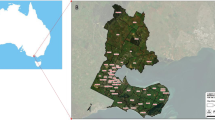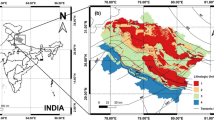Abstract
Indexing methods are used for the evaluation of aquifer vulnerability and establishing guidelines for the protection of ground-water resources. The principle of the indexing method is to rank influences on groundwater to determine overall vulnerability of an aquifer to contamination. The analytic element method (AEM) of ground-water flow modeling is used to enhance indexing methods by rapidly calculating a potentiometric surface based primarily on surface-water features. This potentiometric map is combined with a digital-elevation model to produce a map of water-table depth. This is an improvement over simple water-table interpolation methods. It is physically based, properly representing surface-water features, hydraulic boundaries, and changes in hydraulic conductivity. The AEM software, SPLIT, is used to improve an aquifer vulnerability assessment for a valley-fill aquifer in western New York State. A GIS-based graphical user interface allows automated conversion of hydrography vector data into analytic elements.






Similar content being viewed by others
References
Aller L, Bennett T, Lehr JH, Petty RJ, Hackett G (1987) DRASTIC: A standardized system for evaluating ground water pollution potential using hydrogeological settings. Dublin, Ohio, National Water Well Association, 266 pp
Douglas DH, Peucker TK (1973) Algorithms for the reduction of the number of points required to represent a digitized line or its caricature. Canadian Cartographer 10(2): 112–122
ESRI (2000) ArcView 3.x, Environmental Systems Research Institute, Inc. Redlands, CA
ESRI (2001). ArcGIS, Environmental Systems Research Institute, Inc. Redlands, CA
Evans BM, Myers WL, (1990) A GIS-based approach to evaluating regional groundwater pollution potential with DRASTIC. Journal of Soil and Water Conservation 29:242–245
Frimpter MH (1974) Ground-water resources, Allegheny River Basin and part of the Lake Erie Basin, New York. USGS Basin Planning Report, Reston, VA
Haitjema HM (1995) Analytic element modeling of groundwater flow. San Diego, CA, Academic Press, Inc.
Hart ER (2001) Characterization of aquifer vulnerability using DRASTIC and GIS for the Olean Creek Watershed, Cattaraugus County, New York. Department of Geology, Buffalo, NY, University at Buffalo, 79 pp
Jankovic I (2001) SPLIT: Win32 computer program for analytic-based modeling of single-layer groundwater flow in heterogeneous aquifers with particle tracking, capture-zone delineation, and parameter estimation. Buffalo, NY.
Seaberg JK (2000) Metropolitan groundwater model project summary: Overview of the Twin Cities Metropolitan groundwater model, Version 1.00. Minneapolis, Minnesota, Minnesota Pollution Control Agency
Silavisesrith W (2003) ArcAEM. Buffalo, NY, University at Buffalo, Department of Geography
Strack ODL (1999) Groundwater Mechanics. North Oaks, MN, Strack Consulting, Inc.
Zhang R, Hamerlinck JD, Gloss SP, Munn L (1996) Determination of nonpoint-source pollution using GIS and numerical models. Journal of Environmental Quality, 25:411–418
Acknowledgements
The authors would like to recognize the work and input from all of the colleagues involved in the project, directly and indirectly. This project was funded by the United States Environmental Protection Agency, under the supervision of the University at Buffalo Groundwater Research Group.
Author information
Authors and Affiliations
Corresponding author
Rights and permissions
About this article
Cite this article
Fredrick, K.C., Becker, M.W., Flewelling, D.M. et al. Enhancement of aquifer vulnerability indexing using the analytic-element method. Env Geol 45, 1054–1061 (2004). https://doi.org/10.1007/s00254-004-0973-8
Received:
Accepted:
Published:
Issue Date:
DOI: https://doi.org/10.1007/s00254-004-0973-8




